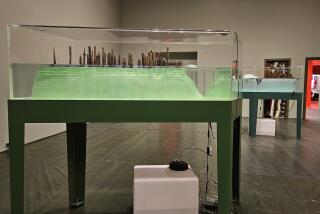Critic’s Notebook: MOCA’s firing of Paul Schimmel is a bad sign
- Share via
Who is the director of the Museum of Contemporary Art? According to the museum it’s Jeffrey Deitch, the former New York art dealer who — with virtually no prior museum experience — assumed the top job at one of America’s leading institutions two years ago.
But don’t be so sure.
Late Wednesday, MOCA dumped Paul Schimmel, its chief curator for 22 years and a prime reason for the museum’s stellar international reputation. No curator working in the United States today has a more impressive record of exhibitions and acquisitions in the field of art since 1950 than Schimmel.
His sudden firing speaks of an intrusive board of trustees and a weak professional staff, which is a lethal combination for an art museum.
Here’s the shocking part: Trustees voted on the firing, and Eli Broad, one of eight life trustees at MOCA, delivered the news.
The board voted? On a curator’s job status?
And a trustee did the dirty work? Where was the museum director?
“The trustee’s duty,” in the pointed words of museum historian Laurence Vail Coleman, “is to have the museum run, not to run it.”
Not since the bad old days of the late 1960s and 1970s, when the then-new Los Angeles County Museum of Art and the old Pasadena Art Museum suffered the slings and arrows of outrageous trustees, have we seen something like this. The result back then was one hobbled museum (LACMA) that was barely a national joke, and a once adventurous institution (PAM) that went under.
It is the job of the director, not trustees, to — well, direct the day-to-day operation, including professional staff. What MOCA’s board did is what a corporation’s board might do in dealing with a company president or CEO. That’s chilling.
An art museum is not a business, but MOCA has a businessman installed in the director’s office and a billionaire-clogged board (at least four, with a total net worth in excess of $21 billion). Schimmel’s dismissal means that the museum’s institutional culture is now entirely corporate.
What an extraordinary, tragic devolution. MOCA was born in 1978 and 1979 when a group of artists — not collectors, art dealers, civic leaders or wealthy businessmen and -women — got together to brainstorm. The seed germinated. The new museum slowly professionalized during the next decade.
Over the course of a generation, it grew into an international powerhouse. For most of that time Schimmel was lead curator.
His 20-year run of ambitious exhibitions is remarkable. It began with 1992’s eye-boggling “Helter Skelter: L.A. Art in the 1990s,” which catapulted the city’s burgeoning reputation as a production center for new art, and “Hand-Painted Pop: American Art in Transition, 1955-62,” an incisive historical show that revised our understanding of the way Pop art emerged from an age of abstraction.
That initial artistic focus — L.A. plus history — came together in last fall’s “Under the Big Black Sun: California Art, 1974-81,” Schimmel’s sprawling extravaganza for Pacific Standard Time. The wide-ranging survey scanned the difficult years bracketed by the ouster of Richard Nixon and the coronation of Ronald Reagan — two U.S. presidents from Los Angeles — in no fewer than 500 works from 130 artists. Not incidentally, it also surveyed the city’s artistic run-up to MOCA’s birth.
Many shows came in between, including one from 2006 that ranks among the great modern museum achievements.
“Robert Rauschenberg: Combines” was based on MOCA’s unparalleled collection of 11 works from a revolutionary series that, between 1954 and 1964, cross-pollinated painting, sculpture, photography and printing in ways that still resonate in today’s art. Schimmel managed to assemble 70 combines — works that are fragile, extremely valuable and difficult to borrow. That no one had done it before spoke volumes about the museum and its chief curator.
Now, with Schimmel’s departure, no one is left on MOCA’s staff with the stature or experience to pull off a coup like that — including its director. He certainly wasn’t the only gifted curator building the permanent collection and doing important exhibitions. But as chief curator, he just as certainly set the tone.
One less-noticed measure of a museum’s long-term institutional success is the quality of the jobs filled by curators who leave, moving on to expand their horizons. Take two of MOCA’s curatorial defections, both after the tumultuous 2008 fiscal meltdown.
Ann Goldstein, 55, is now director of the Stedelijk Museum in Amsterdam, since World War II one of Europe’s most adventurous museums. In September, Philipp Kaiser, 39, assumes the directorship of the Museum Ludwig in Cologne, Germany, epicenter of new European art.
It’s instructive that Goldstein and Kaiser are heading European museums rather than American ones. In Europe, art museums are largely curator-driven. In the U.S., they are more trustee-driven. MOCA was fertile ground for curators deeply involved in an institutional mission where, among its constituency, artists are first among equals.
Funding is the primary reason for the difference. Many European museums receive public subsidies that American institutions do not enjoy. Both systems have their strengths and weaknesses. But the balancing act between staff professionals and trustees in the U.S. is precarious — and this week MOCA toppled it.
No curator does — or should — have a lifetime appointment. But neither should a curator who was instrumental in establishing a museum’s remarkable reputation over the course of 22 years on the job be repaid with a shoddily delivered pink slip.
How can we tell that this was handled badly? Easy.
Word of the firing did not initially come from the museum. It came instead from outside by way of anonymous late-night email, followed by blog posts, Twitter blurbs and old-fashioned reporting.
Even then, MOCA said it would issue a press release about Wednesday’s decapitation — on Friday. (When it finally appeared, nothing much was added to the news beyond gushing praise for the victim, though it clung to the euphemism “resigned.”) That 36-hour sequence speaks not of unconventional thinking but of institutional ineptitude, indifference and even callousness. The museum was unprepared.
Termination was, frankly, not unexpected. Tensions between Schimmel and Deitch, MOCA’s director, were obvious from the start. They’ve only gotten worse over time. The conflict has been a regular topic of art-world gossip.
Tensions were also evident with various trustees, dating at least to 2008. Some board leaders, faced with their own fiduciary irresponsibility in spending down the museum endowment to cover years of deficits, had taken the unconscionable step of considering sales of art from the permanent collection. Schimmel was not shy in objecting.
The curator knew, as some trustees apparently didn’t, that paying operating debts through sales of the museum’s art was suicidal. It would imperil future art donations and destroy the institution’s hard-won reputation among its peers.
It would also reflect on the curator’s legacy. Still, his position was both principled and practical — and regarded as obstructionist by some business people on the board. Buying, selling, investing, making money — that’s what business people do.
Sunday starts the museum’s new fiscal year. With Schimmel’s crude ouster Wednesday, the financial position of the “company,” its equity accounts and balances for long-term assets are all accounted for. Liabilities have been cleared.
The deed was hardly different than a movie studio dumping talent — business as usual in Hollywood. Corporate arrogance goes with the territory. Apparently, it’s also now the style — and substance — at the Museum of Contemporary Art.
More to Read
The biggest entertainment stories
Get our big stories about Hollywood, film, television, music, arts, culture and more right in your inbox as soon as they publish.
You may occasionally receive promotional content from the Los Angeles Times.











